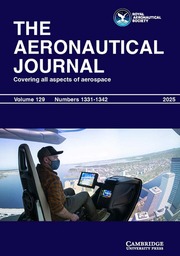No CrossRef data available.
Article contents
Aeroelastic design and flight testevaluation of the Ranger 2000 trainingaircraft
Published online by Cambridge University Press: 04 July 2016
Abstract
The paper describes the aeroelastic analysis for thedesign, the ground verification tests and the flighttest programme, for the Ranger 2000 trainingaircraft, developed jointly by Dasa and RockwellInternational between 1991 and 1994, as a competitorfor the next generation US Air Force and Navy JointPrimary Advanced Training System (JPats). Specialefforts with respect to the aeroelastic stabilitywere required for the T-tail configuration, for thedesign of the manual flight control system, and forthe establishment of sufficient mass balance for thecontrol surfaces. Several ground vibration testswere performed for the complete aircraft and forindividual components for all major designimprovements during the flight test evaluation. Tominimise the required time for these tests, highlymodular test equipment was required. For anefficient flutter flight test programme a reliableexcitation system was chosen. This system consistsof slotted rotating cylinders, mounted on smallvanes, which can be attached to any aerodynamicsurface. This equipment creates defined unsteadyaerodynamic forces to excite the eigenmodes of thestructure.
Quasi-on-line frequency and damping data evaluationbetween consecutive flight test points was madepossible by installing the required hardware andsoftware directly at the flight test quick-lookcontrol room, for the direct use of telemetry data.With this approach only a small number of dedicatedflutter flights was required.
Information
- Type
- Research Article
- Information
- Copyright
- Copyright © Royal Aeronautical Society 1996

